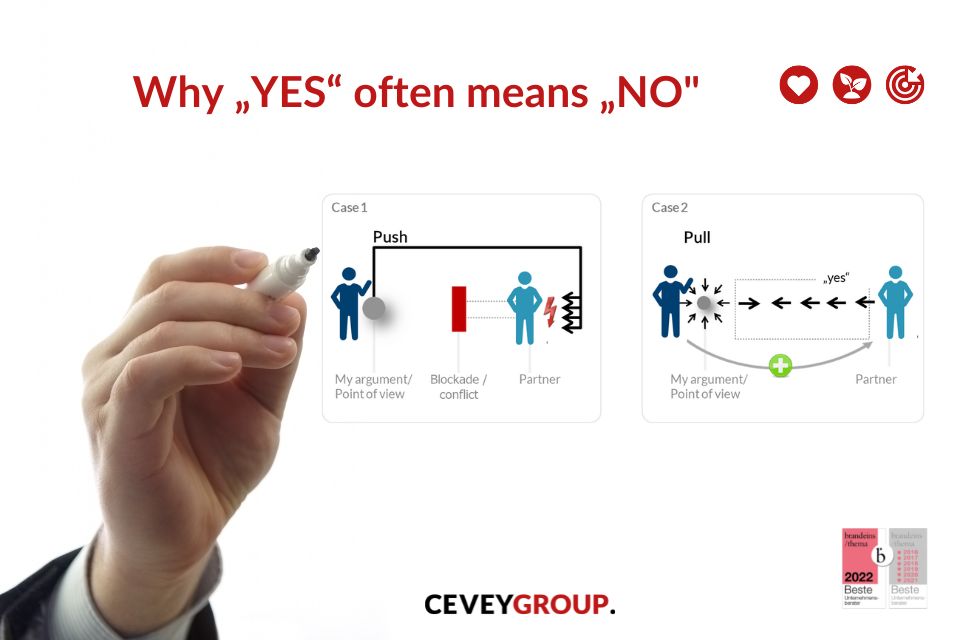Those who reluctantly say “yes” are not following you! How you can effect genuine agreement.
The modern working world is fast-paced and demanding at the same time. Almost everyone has more work on their plate than they would like. At the same time, complex projects require a high degree of cooperation, even across departmental boundaries. In leadership as in lateral communication, we need genuine buy-in from our counterparts so that words are really followed by action. The standard strategy is to “put the pressure on”, but that often doesn’t work.
A (negative) example:
You need timely information from a management colleague for an important presentation to the executive team. It’s about a big project. The colleague is too friendly for a clear no, but always has a lot of tasks and, from experience, reacts sluggishly. What do you say? The classic is:
“You know I absolutely need your data, otherwise I run the risk that the project budget will not be approved. So don’t leave me hanging!”
The colleague sighs and replies more or less half-heartedly: “Okay. I’ll try … .”
Result: As a rule, you wait in vain, have to ask several times and increase the pressure. This stresses and wears you down.
It’s not surprising. How do you react yourself when you are put under pressure? Probably annoyed and defensive. If you can’t block the request, you reluctantly agree, but push it far down in your priority.
Bottom line: we can’t make other people do anything. We can only create the conditions for them to move themselves.
The solution: Create a pull!
Let’s stay with the situation described above:
“I’d like to talk to you briefly about the XY project. Does it fit?”
The colleague: “What is it about?”
Project manager: “The project is about the sales strategy for the new market segment, which is to be decided at the next management meeting. Now a presentation to the management has been scheduled at short notice for next week, for which I need precise data from you by the day after tomorrow on the market potential in this segment.”
Colleague: “I’m in the middle of the annual financial statements. How do you think this should work?!”
Project manager: “I know this comes at an inopportune time. The presentation date is set and cannot be postponed. And the revenue target for the coming year is attached to this project.” [Pause]
Colleague: “Still, I can’t do magic.”
Project manager: “I realize that the situation is not easy. Let’s figure out together how to make it work. Under what conditions would it be feasible?” [Pause.]
Colleague: “Hm … . I would need to know from you exactly what you need. And we should bring in Mr. Meier right away. He can then prepare the data and I’ll take another look at it.”
Project manager: “That sounds good! I can make an exact list by this afternoon. Would that be sufficient?”
Colleague: “Yes, all right.”
Result: Here the colleague has made the task his own. The chance is high that the project manager will get his data on time.
How to create a persuasive pull
The short example shows: Persuasion takes time. But it’s strategically smarter to invest a few minutes in persuasion than to keep following up and get poor results late.
Persuasion through pull:
- Understanding the other person’s situation (emotional empathy): In the example, “I know this comes at an awkward time” or “I realize the situation is not easy.” Such signals do more than many realize. They are based on a positive basic attitude toward the other person – I assume that the other person is doing his or her best and is not willfully blocking. If you succeed in consciously adopting such a positive attitude, this attitude radiates to your counterpart. I call this the “Positive Loop”.
- Statement about reality (rational empathy): In the example: “The presentation date is set and cannot be postponed. And the sales target for the coming year is attached to this project.” Facts are more effective than personal pressure. Once there is consensus on a situation, you are a big step closer to agreement. I call this tool the “reality anchor.”
- Pause: If the other person is to move, he / she needs time. He / She doesn’t have that if his counterpart is talking at him non-stop. So much does not help much. Give your counterpart the mental space to move towards you!
This is just a small selection of the communication tools that will help you achieve your goals more easily and reliably in the VUKA world.
Because where instructions have become obsolete, a different form of communication is needed: activating instead of directive, empathic instead of pressure!
Author: Dr. Bernhard Cevey, CEO CEVEYGROUP
#leadership #communication #communictiontool #CEVEYGROUP #VUKA

